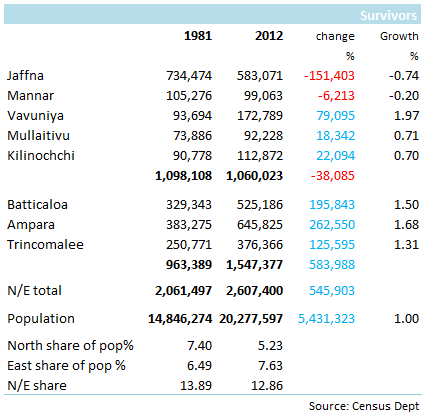Ilankai Tamil Sangam30th Year on the Web Association of Tamils of Sri Lanka in the USA |
|||
 Home Home Archives Archives |
Sri Lanka's North Population Shrinks, East ExpandsConflict populationsby Lanka Business Online, Colombo, June 27, 2012
Population in Sri Lanka's northern Jaffna area has shrunk during a 30-year civil war but parts of the former war zone which was not fully under control of separatists had seen above average growth, new census data shows. The first census conducted in the area since 1981, has shown that the population of the Jaffna district, where ethnic Tamils form the majority had contracted at a rate of 0.74 percent to 583,017 from 734,474. Sri Lanka's population grew at an average rate of 1.0 percent from 1981 to 2012 with the total reaching 20.277 million by from 14.846 million. Mannar, also in the northwest saw its population shrink 0.2 percent to 99,063. "It is evident that out-migration of those who have been displaced due to the conflict situation in those districts have been the reason for the observed reduction in population in those districts," the Census department said in a preliminary report. Mullaitivu where the final battles with Tamil Tiger separatists had taken place had seen growth of 0.7 percent to 92,228. Kilinochchi which served as the stronghold of Tamil Tigers for many years after they were driven out of Jaffna, taking part of the population with them, had also seen an increase.
Vavuniya, which served as a frontier district with only a part of it under Tamil Tiger controlhad seen the fastest rate of population growth for any district at 1.97 percent a year. The Census department said people displaced from other districts in the northern province may have settled in Vavuniya. In the Eastern province, which was also partially under separatist control as it had large numbers of ethnic Sinhalese and Muslims population grew fast. Ampara in the East had seen the second highest population growth rate of 1.68 percent a year from 1981 to 2012. The population in Batticaloa grew at an average rate of 1.50 percent and in Trincomalee grew at 1.31 percent. The share of population in north had dropped to 5.23 percent of the total by 2012 from 7.4 percent in 1981. In the east it had grown to 7.63 percent from 6.49 percent. Population plunge in Sri Lanka's Tamil base AFP, June 27, 2012, Colombo -- Sri Lanka's first national census in 30 years has shown a dramatic 20 percent drop in the population of the Jaffna peninsula, the long-time base of Tamil rebels during the island's ethnic conflict. According to a preliminary census report released Wednesday, the population in Jaffna, which the rebels once ran as a de facto separate state in the northeast, had fallen from 734,000 in 1981 to 583,000. Work on the census began last year. The report offered no analysis, but a Tamil legislator in the national parliament said it reflected an exodus during the fighting between Tamil rebels and government forces from 1972 to 2011 that claimed an estimated 100,000 lives. "Our estimate is that out of the one million Tamils who fled the fighting and are living abroad, at least 80 percent were from Jaffna," said Suresh Premachandran. "If not for the war, the population in Jaffna would have been over 1.4 million," he added. One likely consequence of the new census figures will be a reduction in ethnic Tamil minority representation in the national parliament, which is dominated by members of the Sinhalese majority. Seats in the 225-member parliament are allocated on the basis of a region's population. Nine seats are currently allocated for Jaffna, but Premachandran said that would now drop to six. The census put the national population at 20.27 million, about 600,000 down on estimates based on a sample survey carried out in 2001. Sri Lanka's ethnic conflict ended in May 2009, with the final defeat of the Liberation Tigers of Tamil Eelam (LTTE) by government forces. Dispute Over Jaffna Census Figure By Chrishanthi Christopher, The Sunday Leader, Colombo, July 28, 2012 The dispute over the latest population figure arrived at in the Jaffna region by the Census and Statistics Department in 2011 is a storm in a tea cup, claims an economist.
|
||
|
|||
